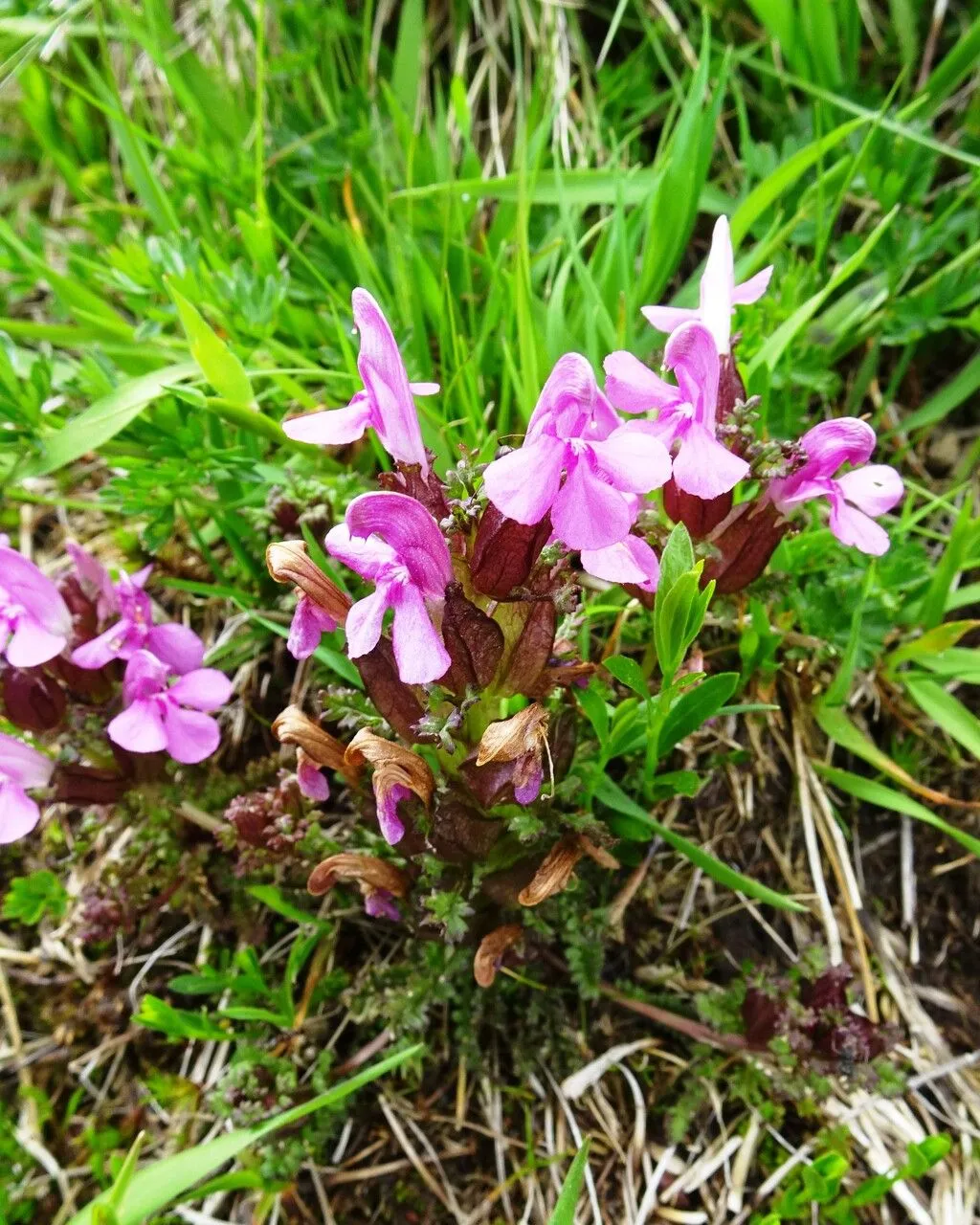
Author: L.
Bibliography: Sp. Pl.: 607 (1753)
Year: 1753
Status: accepted
Rank: species
Genus: Pedicularis
Vegetable: False
Observations: Europe
Lousewort is a distinctive and fascinating plant, scientifically known as Pedicularis sylvatica. It was first described by the renowned botanist Carl Linnaeus in his seminal work “Species Plantarum” (Sp. Pl.: 607) published in 1753. This particular species is indigenous to Europe, where it can often be found thriving in a variety of habitats ranging from moist meadows to heathlands and boggy areas.
Belonging to the family Orobanchaceae, lousewort is a hemiparasitic plant, which means it partly relies on other plants for nutrients while also performing photosynthesis. This allows it to survive and flourish in nutrient-poor environments where other plants might struggle.
Lousewort is a perennial herb that typically grows to a modest height of about 10 to 30 centimeters. Its delicate blooms appear in the spring and early summer, showcasing a range of colors from pale pink to deep magenta. The flowers are intricately shaped, with a unique structure that aids in attracting pollinators such as bees, which are essential for the plant’s reproduction.
In terms of its morphology, lousewort has finely divided, feathery leaves that create a soft, almost fern-like appearance. The stems are often branched and can sometimes display a reddish hue. The plant’s common name, lousewort, is derived from a historical belief that it could cause lice infestations in livestock that grazed upon it. However, this is a myth and has no basis in scientific fact.
Ecologically, lousewort plays a crucial role in its native habitats. By forming symbiotic relationships with surrounding plants, it contributes to the biodiversity and overall health of the ecosystem. Its presence can indicate well-preserved natural habitats with minimal human disturbance.
Pedicularis sylvatica’s intriguing biology and ecological importance make it a subject of interest for botanists and ecologists alike, as it offers insights into the complexity and interdependence of plant communities. Whether you encounter this plant in the wild or study it from afar, lousewort stands out as a remarkable example of nature’s adaptability and intricacy.
Dan: mose-troldurt
Deu: wald-läusekraut, waldmoorläusekraut
Nor: granfrier, skovfrier
Nld: heidekartelblad
Eng: lousewort, small lousewort
Lav: meza janeglite
Fra: pédiculaire des bois, pédiculaire des forêts
Swe: granspira, ängsspira
Cym: blodyn llyffant, cribell goch, cribellau cochion, llys y cŵn, llysiau’r cŵn, llysiau’r eglwys, mel-y-cŵn, melog y borfa, melog y cŵn, melsugn, melsugn y borfa
En: Lousewort, Small lousewort, Heath Lousewort
Be: Увярэднік лясны
Bg: Горско въшливче
Kw: Lowles
Cs: Všivec lesní
Da: Mose-Troldurt
Nl: Heidekartelblad
Fi: Nummikuusio
Fr: Pédiculaire des bois, Pédiculaire des forêts, Herbe aux poux
De: Wald-Läusekraut (Waldläusekraut), Wald-Läusekraut, Waldmoorläusekraut, Wald-Laüsekraut, Waldmoor-Läusekraut
It: Pedicolare silvestre
Lv: Meza janeglite
Lt: Miškinė glindė
No: Kystmyrklegg, Granfrier, Skovfrier
Pl: Gnidosz rozesłany
Ru: Мытник лесной
Sk: Všivec lesný
Sv: Granspira, Ängsspira
Uk: Шолудивник лісовий
Cy: Melog y cŵn, Blodyn Llyffant, Cribell Goch, Cribellau Cochion, Llys y Cŵn, Llysiau’r Cŵn, Llysiau’r Eglwys, Mel-y-Cŵn, Melog y Borfa, Melsugn, Melsugn y Borfa
Taken Sep 6, 2021 by Darren Giddins (cc-by-sa)
Taken Sep 6, 2021 by Darren Giddins (cc-by-sa)
Taken May 15, 2021 by Darren Giddins (cc-by-sa)
Taken Jun 14, 2021 by Alain Bigou (cc-by-sa)
Taken Jun 14, 2021 by Alain Bigou (cc-by-sa)
© copyright of the Board of Trustees of the Royal Botanic Gardens, Kew.
© copyright of the Board of Trustees of the Royal Botanic Gardens, Kew.
© copyright of the Board of Trustees of the Royal Botanic Gardens, Kew.
Taken Apr 29, 2022 by Krzysztof Golucki (cc-by-sa)
Taken Apr 16, 2022 by beurny (cc-by-sa)
Taken Jul 27, 2022 by margarida vila (cc-by-sa)
Taken Aug 16, 2021 by Pierre LEON (cc-by-sa)
Taken Jun 14, 2021 by Alain Bigou (cc-by-sa)
Taken Apr 16, 2022 by beurny (cc-by-sa)
Taken Jun 14, 2021 by Alain Bigou (cc-by-sa)
Taken Apr 24, 2008 by Tela Botanica − Michel PANSIOT (cc-by-sa)
Taken Aug 16, 2021 by Pierre LEON (cc-by-sa)
Taken Jun 14, 2021 by Alain Bigou (cc-by-sa)
Taken Nov 20, 2022 by g v (cc-by-sa)
Taken Jan 1, 1800 by Tela Botanica − Daniel MATHIEU (cc-by-sa)
Taken Jul 9, 2013 by Tela Botanica − Liliane Roubaudi (cc-by-sa)
Taken May 31, 1875 by Tela Botanica − Herbier PONTARLIER-MARICHAL (cc-by-sa)
Taken Jun 14, 2021 by Alain Bigou (cc-by-sa)
Taken Jun 5, 2022 by Llandrich anna (cc-by-sa)
Taken Jul 15, 2007 by Photoflora – Benoit BOCK (©)
Taken Jul 15, 2007 by Photoflora – Benoit BOCK (©)
Taken Jul 3, 2013 by Tela Botanica − Jean-Jacques HOUDRÉ (cc-by-sa)
Taken Jun 4, 2017 by Tela Botanica − Sylvain PIRY (cc-by-sa)
Taken Jun 2, 2015 by Tela Botanica − Sylvain PIRY (cc-by-sa)
Growth habit: Forb/herb
Ph maximum: 4.0
Ph minimum: 3.0
Light: 7
Atmospheric humidity: 6
Soil nutriments: 2
Family: Myrtaceae Author: (F.Muell.) K.D.Hill & L.A.S.Johnson Bibliography: Telopea 6: 402 (1995) Year: 1995 Status:…
Family: Rubiaceae Author: Pierre ex A.Froehner Bibliography: Notizbl. Bot. Gart. Berlin-Dahlem 1: 237 (1897) Year:…
Family: Sapindaceae Author: Koidz. Bibliography: J. Coll. Sci. Imp. Univ. Tokyo 32(1): 38 (1911) Year:…
Family: Asteraceae Author: A.Gray Bibliography: Pacif. Railr. Rep.: 107 (1857) Year: 1857 Status: accepted Rank:…
Family: Fabaceae Author: Medik. Bibliography: Vorles. Churpfälz. Phys.-Ökon. Ges. 2: 398 (1787) Year: 1787 Status:…
Family: Aspleniaceae Author: (Cav.) Alston Bibliography: Bull. Misc. Inform. Kew 1932: 309 (1932) Year: 1932…